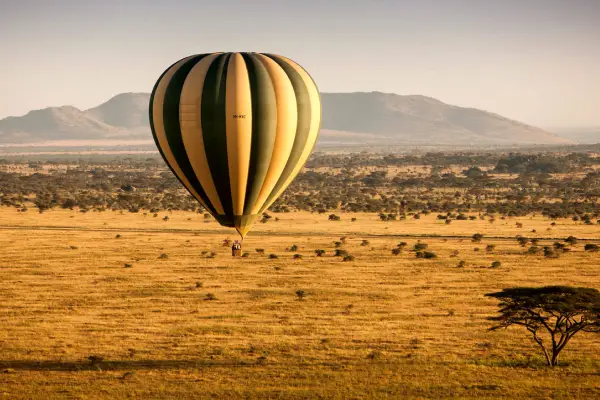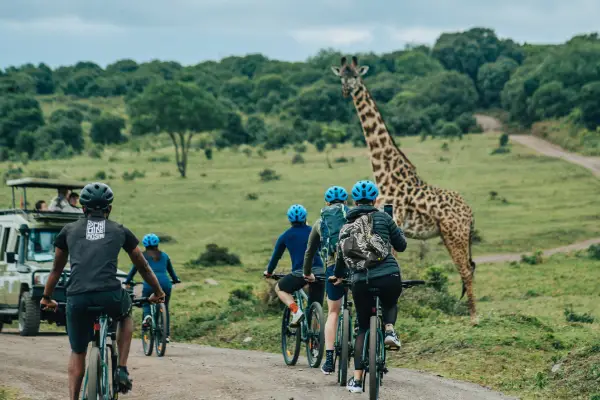100% refundable deposits
100% refundable deposits
Getting to Tanzania is simple, with flying being the top choice for most travellers. The main airports include Julius Nyerere International Airport in Dar es Salaam, Kilimanjaro International Airport near Arusha, and Abeid Amani Karume International Airport in Zanzibar.
For those nearby, travelling by road from Kenya, Uganda, and Rwanda is easy thanks to smooth bus services and border crossings. From Zambia, you can catch the TAZARA train.
You can also arrive by sea through ports in Dar es Salaam and Zanzibar, though it’s less common. This makes Getting to Tanzania for your Tanzania Safari Tours convenient and flexible.
Flying to Tanzania is straightforward with its three main airports - Julius Nyerere International Airport in Dar es Salaam, Kilimanjaro International Airport near Arusha, and Abeid Amani Karume International Airport in Zanzibar.
For exploring further within the country, such as visits to Arusha, and Zanzibar, domestic flights are available. These flights vary in cost from $50 to $300 for a one-way ticket, offering a convenient way to enhance your Tanzania Travel experience.
Taking a bus to Tanzania is a common and affordable option, especially from neighbouring countries like Kenya, Uganda, Rwanda, and Zambia. This method of Getting to Tanzania offers both convenience and a chance to see the countryside.
Buses head to Dar es Salaam from Nairobi's Nairobi River Bus Station and Machakos Bus Station, as well as from Mombasa's Mwembe Tayari Bus Terminal. The trip costs between $20 and $30 from Nairobi and takes about 12-14 hours, while from Mombasa it costs about $25 to $35 and takes 15-17 hours.
In Kampala, buses depart from Namayiba Bus Terminal and the Old Taxi Park with fares ranging from $30 to $50 for a 24–26-hour journey to Dar es Salaam.
From Kigali's Nyabugogo Bus Station and Taxi Park, a bus ride to Dar es Salaam costs about $40 to $60 and also takes around 24-26 hours.
Buses from Lusaka's Intercity Bus Terminus to Dar es Salaam cost around $40 to $60, with the travel time averaging 24-26 hours.
These bus routes are a practical way to navigate Tanzania Travel, allowing you to effortlessly connect to major destinations like Dar es Salaam, from where you can explore further or start your Tanzania Safari Holidays.
Taking a train is a fun way to get to Tanzania. There are two main train services you can use on your Safaris in Tanzania:
This train runs from Dar es Salaam in Tanzania to Kapiri Mposhi in Zambia. It has beds for sleeping and a car where you can eat. The trip is long—about 45 hours—and covers 1,860 kilometres (1,156 miles). A first-class ticket costs around 47,000 Tanzanian shillings.
This service offers trains from Dar es Salaam to Kigoma by Lake Tanganyika. TRC also has trains in Dar es Salaam that help people get around the city.
These trains are a great way to see the country and start your Tanzania Safari Tours. You can relax, watch the scenery go by, and arrive ready for adventure.
Travelling to Tanzania by car is a popular choice for visitors from nearby countries because of the many border crossings.
You can drive into Tanzania through border spots like Namanga, Taveta, and Isebania. It takes about 5-6 hours to drive from Nairobi to the Tanzanian border, a distance of about 280 kilometres (174 miles).
To get to Tanzania from Uganda, you can use the Mutukula border crossing. This route lets you reach Tanzanian cities like Mwanza and Dar es Salaam. The drive from Kampala to the border takes around 10-12 hours, depending on how fast you drive and the road conditions.
The Rusumo border post is how many travellers from Rwanda enter Tanzania. This road leads to places like Bukoba, Mwanza, and Dar es Salaam. The drive from Kigali to the Tanzanian border is about 8-10 hours long and covers around 340 kilometres (211 miles).
These roads make it easy to drive into Tanzania and start exploring right away, perfect for kicking off your Tanzania Safari Tours and seeing lots of beautiful places along the way.
You can also Travel To Tanzania by water. The country has major ports like Dar es Salaam, Tanga, and Mtwara. Dar es Salaam is the biggest and busiest of these ports.
If you're coming from nearby places like Kenya, you can take a ferry. Also, some cruise ships stop at these ports, bringing visitors who are looking to explore Tanzania. This way, you can enjoy the ocean views as you get ready for your adventures in Tanzania.
Getting to Tanzania is easy, whether you come by plane, bus, train, or even boat.
Now you know all the ways to get here, so why not go ahead and plan your trip? Pack your bags and get ready for an exciting Tanzania Safari Tour!

All itinerary activities with a local, certified guide

We provide Kailas X3 III alpine tents with vestibules

All nutritious meals while on the trek.

To and from the airport and everything in between

All permit fees and taxes

Solo-friendly by nature, join our small groups



 25°C
25°C
 45MM
45MM
January is a lush and vibrant time in the Serengeti, marking the peak of the calving season. The southern plains come alive with newborn wildebeests and zebras, offering a spectacular wildlife experience. The weather is warm with occasional showers, creating a green and flourishing landscape. This period is ideal for observing young animals and their interactions with predators, all while enjoying a relatively quiet park with fewer tourists.
 25°C
25°C
 45MM
45MM
February continues the calving season with a high concentration of newborns across the southern Serengeti. The lush vegetation supports large herds of wildebeest and zebra, and predator activity remains high, making it an exciting time for wildlife viewing. The weather remains warm with occasional rains, and the park is still less crowded, providing excellent opportunities for intimate wildlife experiences.
 25°C
25°C
 45MM
45MM
By March, the calving season begins to wind down, and the herds start moving northward. The landscape remains green and vibrant due to ongoing rains, but the vegetation starts to thicken, which can make wildlife spotting more challenging. However, the park’s reduced number of visitors means a more serene safari experience, and the start of the migration northward offers exciting prospects for observing the moving herds.
 25°C
25°C
 45MM
45MM
April is characterized by heavy rains, making it one of the wettest months in the Serengeti. The landscape transforms into a lush paradise, but the roads can become muddy and challenging to navigate. Wildlife viewing can be more difficult due to dense vegetation and wet conditions, but the park’s reduced tourist numbers offer a quieter experience and a unique opportunity to see the park in its most verdant state.
 25°C
25°C
 45MM
45MM
May continues with the long rains, maintaining the park’s lush, green appearance. The increased vegetation can obscure wildlife, making sightings more difficult. However, this is a less crowded time, providing a peaceful safari experience. As the migration herds start moving north, there are opportunities to witness the beginnings of the migration, offering a quieter but still engaging wildlife experience.
 25°C
25°C
 45MM
45MM
June marks the beginning of the Avg Temperature, with warm, pleasant weather and minimal rainfall. The landscape starts to dry out, and wildlife concentrations increase around water sources, making it easier to spot animals. The Great Migration typically begins its journey northward, and the park’s clearer conditions provide excellent opportunities for viewing river crossings and large gatherings of wildlife.
 25°C
25°C
 45MM
45MM
July is one of the prime months to visit the Serengeti, as the Avg Temperature is in full swing. The Great Migration reaches the northern Serengeti, where dramatic river crossings occur. The dry conditions ensure clear visibility and easier access to wildlife, though it is also the height of the tourist season. The warm weather and high concentrations of wildlife make for an unforgettable safari experience.
 25°C
25°C
 45MM
45MM
August continues with excellent conditions for wildlife viewing as the Great Migration remains in the northern Serengeti. The dry, warm weather makes for clear skies and easy access to the park’s various wildlife hotspots. This is an ideal time for witnessing the spectacular river crossings and observing large predator populations, though it can be quite busy with tourists.
 25°C
25°C
 45MM
45MM
In September, the Avg Temperature persists, providing excellent conditions for game viewing. The Great Migration herds are still moving south, and wildlife remains concentrated around water sources. The dry weather and open landscapes make it easier to spot animals, and the crowds start to thin out slightly, offering a more relaxed safari experience compared to peak months.
 25°C
25°C
 45MM
45MM
October marks the transition from the Avg Temperature to the short rains. The Great Migration herds continue their southward movement, and wildlife is concentrated around remaining waterholes. The landscape begins to show signs of green as the rains approach, and the park sees fewer tourists, making for a more tranquil and enjoyable safari experience.
 25°C
25°C
 45MM
45MM
November brings the start of the short rains, with occasional showers and a rapidly greening landscape. The migration herds continue moving south, and the park’s transformation into a lush environment offers beautiful scenery. The reduced number of visitors and vibrant landscape provide a serene and picturesque safari experience.
 25°C
25°C
 45MM
45MM
December features ongoing short rains, which further enhance the park’s lush and green appearance. The calving season begins in the southern Serengeti, with herds returning and newborn animals becoming more common. The warm weather and vibrant environment, combined with fewer tourists, create an ideal setting for observing new life and enjoying a peaceful safari.

Talk to Us. Our Experts are just a Click Away!












I hiked Killimanjaro with a local company called Ascend Tanzania. I could not recommend a company more highly.






I had no idea what I was signing up for when I decided, without any prior experience of a trek of this calibre






Climbing Kilimanjaro was one of my greatest mountain experience so far.






Ascend is a top-notch Kilimanjaro tour guide company that I would highly recommend






Ascend tanzania is an affordable company run by the most efficient local people!
"Excellent Company To Climb With"
I booked my Kilimanjaro climb (6 Day Machame route) with Ascend Tanzania because I was travelling solo and on a budget
Read Reviews